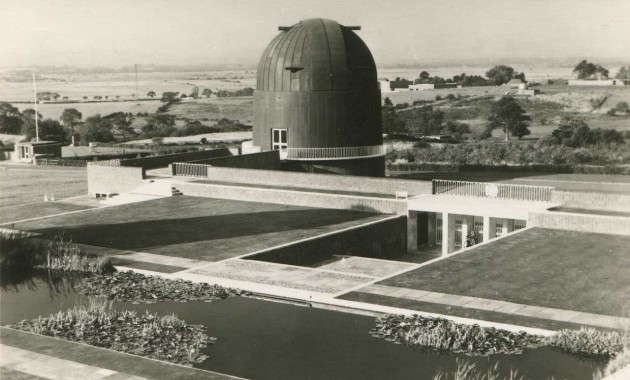…where east meets west
- Home
- Brief History
- The Greenwich Meridian
- Greenwich
(1675–1958) - Herstmonceux
(1948–1990) - Cambridge
(1990–1998) - Outstations (1822–1971)…
- – Chingford (1822–1924)
- – Deal
(1864–1927) - – Abinger
(1923–1957) - – Bristol & Bradford on Avon
(1939–1948) - – Bath
(1939–1949) - – Hartland
(1955–1967) - – Cape of Good Hope
(1959–1971)
- Administration…
- – Funding
- – Governance
- – Inventories
- – Pay
- – Regulations
- – Royal Warrants
- Contemporary Accounts
- People
- Publications
- Science
- Technology
- Telescopes
- Chronometers
- Clocks & Time
- Board of Longitude
- Libraries & Archives
- Visit
- Search
Telescope: Merz 12.8-inch Visual Refractor (1859)
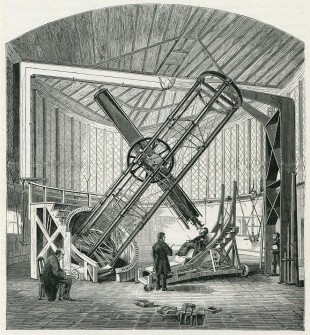
The Great Equatorial with the 12.8-inch Merz Refractor. Originally published in the 1862 volume of The Leisure Hour, the image was reused in the 1891 edition of Dunkin's The Midnight Sky
The 12.8-inch Merz was the Observatory’s largest equatorially mounted refractor until the arrival of the 13-inch Astrographic Telescope in 1890. With a tube made of wood, the telescope had an object glass of 12.8-inches diameter and a focal length of 17 feet 10 inches.
The 12.8-inch Refractor was dismounted in 1891 to make way for the new 28-inch Refractor which had been designed to replace it on the same mounting. The 28-inch refractor (rather than the 12.8-inch Merz) then became known as Great Equatorial (or South-East Equatorial). However in later years, for clarity, that particular telescope was more generally referred to as the 28-inch equatorial.
The 12.8-inch Merz was mounted on the Lassell Equatorial from 1892 to 1895 in place of the Lassell 2-foot reflector. It was then given a new steel tube and used as the guiding telescope for the new Thompson 26-inch Photographic Refractor. The Thompson telescope was mothballed in 1939 at the outbreak of war and remained out of use until 1958, when it was brought back into service in a new home in Dome E at Herstmonceux. It remains there under the care of The Observatory Science Centre, complete with the 12.8-inch refractor as its guiding telescope.
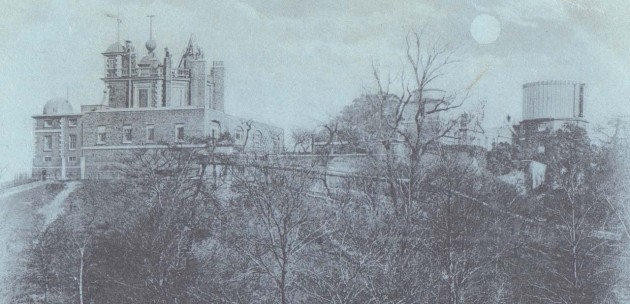
The Observatory from the west. The Great Equatorial Building with its drum dome is on the right. The Observatory would have looked much like this from the late 1860s until the late 1880s when Christie built the Astrographic Dome. Detail from a postcard published anonymously c.1900
Making the case for a larger equatorial
On 18 October 1855, Airy put the case for a new equatorial instrument to the Observatory’s Board of Visitors. At that time, the Observatory had two equatorials, (both of which were refractors). These were the 6.7-inch Sheepshanks and the 4.1-inch Shuckburgh. Both had significant drawbacks. The setting circles of the Sheepshanks were very small, making it unfit for accurate determinations of the place of a celestial body. It also had an object glass that was not of the top quality. The Shuckburgh on the other hand had very large graduated circles. The declination circle had been redivided in 1838/9, but the divisions on the hour circle had not and had since become illegible. The telescope also had a frame that was too weak and a location where it was unable to command a large part of the sky because of the close proximity of Flamsteed House. Airy argued that while the hour-circle could be redivided, the way it had been constructed would make this difficult … and that even if this was done successfully, the Observatory would still ‘have a small indifferent telescope, on a weak frame, in a position bad beyond anything that an astronomer ever imagined.’
Before writing his address, Airy had made soundings of what large object glasses were available on the market (they were in short supply). He reported that Merz had one of 12 French inches (12.8 English inches) aperture, and 17½ French feet (18.65 English Feet) focal length, at the price of 13,300 florins (about £1,100), which he told the Visitors might still be available. He proposed to mount it as an English Equatorial which he regarded as superior to German Equatorials for the accurate determination of celestial places.
Airy’s address was not given in person but was sent to each of the members of the Board. Their response was favourable, so on the strength of this, Airy approached the Admiralty who agreed to fund the telescope (which Airy had costed at £2000).
Click here for the full text of Airy’s address.
A Neptune myth?
Back in 1846, when Neptune was discovered, the Observatory and Airy in particular, received a great deal of criticism in the public press for the fact that the discovery was not a British one. This was in part due to the fact that many regarded Greenwich as the world’s leading observatory and partly because the English astronomer John Couch Adams had not only predicted its presence, but also where in the sky it would be seen, and had approached Airy for help in finding it. Airy took an interest and in turn had asked Challis at Cambridge to organise a search as he had the use of an 11.6-inch refractor – the Northumberland Equatorial – that Airy himself had designed for work that required very precise measurements.
There were many good reasons why Greenwich itself did not directly participate in the search for the planet. Even if Airy had considered a search for the planet as falling within the remit of the Observatory (which he probably didn’t), any search conducted from Greenwich was unlikely to have been successful due to the unsuitability of its two equatorials for such a task.
Although there is no evidence that the Neptune incident had any bearing on Airy’s pursuit of a larger equatorial, a number of late twentieth century historians have suggested that it may have been a motivating factor. Such notions may stem from Howse’s Volume 3 of Greenwich Observatory (London 1975), where, in the Historical Summary that he wrote for the Merz Refractor, he makes brief mention of some of the events in the lead up to the planet’s discovery. Although Howse himself did not directly say that Neptune incident was behind Airy’s quest for a larger instrument, his mention of the affair may have sowed the seeds in the minds of others!
Commissioning the telescope
Having secured Admiralty approval, Airy contacted Merz to ask him to send the object glass to Greenwich for testing. Merz however declined, stating that they were anxious to provide the Observatory with the best possible object-glass and going on to explain that they had a second one that was nearing completion and that they would send the better of the two when it was completed. In the meantime Airy began to refine his thoughts on the precise design of the mounting which he planned to base on those of his earlier designs for the Cambridge and Liverpool Equatorials. The key question was whether to make the supporting framework of the mounting out of wood or steel. Airy opted for the later. Anxious to press on with getting the new building and mounting constructed, Airy asked Merz for details of the greatest likely aperture and focal length of the object glass. The answer came back that it would not exceed 206 French inches (18 feet 4 inches, English measure). The mounting was therefore designed to accommodate a telescope of this size. As it turned out, the object glass supplied had a focal length that was shorter. In the description of the instrument published by Airy in the introduction to each of the annual volumes of Greenwich Observations, it was initially given as about 16 feet 6 inches. In the volume for 1871 this was changed (without explanation) to 17 feet 10 inches. The figure of 17 feet 10 inches was used in all the subsequent volumes until 1908 when a description ceased to be published. Measurements made on Fig 37 in the more detailed account published by Airy in the 1868 volume of Greenwich Observations (link below) suggest that the length of the telescope tube was about 16 feet 6 inches and that the tube together with the eye-piece had a combined length of about 18 feet 3 inches. In the 1980s, Michael Lowne, (one of the Observatory's longstanding members of staff) carried out a series tests to find out more about the qualities and defects of the object-glass. His findings were published in his paper: The Object-Glass of the Greenwich Great Equatorial Telescope (Journal for the History of Astronomy, Vol.19, NO. 3/AUG, P.169, 1988). Amongst his many findings was that the Object Glass had a back focal length (the distance from the back of the lens to the principal focus) of 212.4 inches (17 feet 8.4 inches).
When deciding who should build the telescope, Airy selected the same companies that he had earlier used to construct his Altazimuth telescope in the 1840s and the Northumberland Equatorial at Cambridge in 1833. It was constructed by Ransomes and Sims (formerly Ransomes and May) as Engineers, and Mr. Simms of Troughton and Simms as Instrument Maker and Optician. In addition, Dent was contracted to provide the driving clock, which was powered by a head of water.
Sidereal time from the Observatory’s master clock
The observing dome was fitted out with two clocks showing sidereal time. To start with these were both regulated (as were certain other clocks) directly by electrical impulses received from the Transit Clock (which at that time was the Observatory’s main time standard). One was a half-seconds-clock placed on the foundation frame of the telescope’s South Pier, near to the Time-Microscope which was supplied by Dent; the other was a half-seconds-chronometer fixed to the eye end of the telescope which was supplied by Shepherd.
In 1871 the Observatory obtained a new Sidereal Standard Clock by Dent & Co (Dent No. 1906) which took over the role of regulating those clocks previously regulated directly by the Transit clock. It was located in the basement of the Magnetic Observatory.
Airy’s description of the instrument
As well as publishing a detailed description of the telescope and its mounting, Airy also wrote a short account which was published each year in the Introductions to the volumes of Greenwich Observations, first appearing in the volume for 1860. Airy’s account was much shortened by Christie when he became Astronomer Royal in 1881. It appeared in all the subsequent volumes until 1908. The following text comes from the volume for 1870. Click here to read it in its original format.
‘The Great Equatoreal, constructed by Messrs. Ransomes and Sims as Engineers, and Mr. Simms as Instrument Maker and Optician. – A complete description of this instrument, with engravings, is attached as Appendix to the volume for 1868. The following account will give information on its principal peculiarities. It is to be premised that the form of the instrument is the “English Equatoreal;” the polar-axis turning on pivots at its extreme ends, and including between its two sides the telescope and declination-circle attached to it; the frame which carries the telescope and declination-circle having its pivots at opposite extremities of the declination-axis.
The “South-East Dome,” which contains this instrument, is in close proximity to the south-east corner of the Record Room, and occupies part of the isthmus which connects the Observatory Hill with the upper part of Greenwich Park. It is in form an octagon, with an attached projection on the north side, containing the staircase. The length of the line drawn perpendicularly through opposite sides of the octagon is 31 ft. 4in. The building consists of three stories; that of the ground floor contains the Water-Clock-Movement (to be mentioned below), and is used for other purposes unconnected with the Equatoreal; the middle story has been used, in 1870, as a room for chronometers; the upper story is properly the Equatoreal Room. To the top of the walls of that room, the building is fire-proof.
The walls are built to the height of 9 ft. 5 in. above the floor of the Equatoreal Room. Arches are turned across the angles of the octagon, so as to make the upper surface of the walls a polygon of sixteen sides. Upon this surface is planted a circular wooden ring or curb, upon which is fixed an iron curb, containing a channel in which cannon balls run, and containing also a circular rack or toothed wheel (its teeth pointing upwards), which surrounds the room. Upon the balls runs another curb with inverted iron channel, which curb is the foundation of the revolving dome. The dome is drum-shaped; its clear inner height above the floor being 25 ft. 8 in. It carries a toothed wheel which works in the fixed rack just mentioned, so that a rotation of the wheel causes the dome to revolve. This rotation is effected by winch-work, which is carried by an iron frame that is attached to the interior of the dome, and projects downwards to a convenient level. The person who turns the winch must follow the movement of the dome; his place is always opposite to the shutter-opening. The opening for observation is 3 feet wide; it extends, without interruption, from the curb of the dome to the top of the dome-wall, and along its nearly flat top about 2 feet beyond its center. One nearly horizontal shutter covers the whole opening in the flat top, and one vertical shutter covers the whole opening in the dome-wall; each of these parts can be opened independently of the other. An iron frame attached to the interior of the dome projects downwards to a convenient position, and carries the winch-machinery by which the shutters are opened and closed.
The South Pier, which supports the lower extremity of the polar-axis, is built from the ground through the lower and middle stories, nearly to the floor of the Equatoreal Room, where the iron foundation-frame is planted which carries the bearing-piece for the lower pivot and its antifriction wheels, the attachment for the slow-motion screw, and the fixed time-microscope. The North Pier is built to the same height in two massive trapezoidal pillars (upon one foundation), united by strong stones at each of the floors ; the entrances of the lower and middle rooms pass between these pillars. Upon the upper surface of the pier is planted a lofty iron frame (cast in one piece by Messrs. Ransomes and Sims), the top of which carries the bearing piece for the upper pivot, the antifriction wheels, and the apparatus subservient to the transmission of gas and to galvanic communications. The entrance to the Equatoreal Room passes between the upright parts of this iron frame; they are, however, sufficiently distant from the wall to permit the passage of the irons, projecting downwards from the dome, which carry the winch-apparatus for moving the dome and opening its shutters.
The polar-axis consists of two braced skeleton-prisms, each about 22 feet long, 2 feet apart, united at the bottom and at the top by ovals about 8 feet long (in the direction parallel to the declination-axis), and 5 feet broad (in the transverse direction). The pivot of the lower oval, projecting downwards, is long enough to carry the Hour-Circle, which is a cast-iron circle 6 feet in diameter, revolving freely on the long pivot, but admitting of being connected with the lower oval by clamp and slow-motion-screw. The circumference of this circle is racked, and the worm or endless screw, to which motion is given by the clock-movement, acts in it. The circle bears two graduations: one which is viewed by a fixed microscope (attached to the iron foundation-frame), whose reading, when the circle has been properly placed and the clock-movement is properly adjusted, always gives True Sidereal Time; another, which is viewed by two microscopes carried by the lower oval, and whose reading (when the clock-movement, &c., are adjusted) always gives the Right Ascension of the object under view. There are also independent means of fixing the lower oval, when the use of the clock-movement is not desired. The upper oval is cut through on one side as far as its pivot, to allow the telescope to view the pole. Its pivot is perforated to allow the passage of a gas pipe, by which lights on various parts of the instrument are supplied; and it carries four insulated galvanic rings (connected, as will presently be mentioned, with four wires that lead to springs which touch rings upon the declination-axis), touched by four springs which are attached to the lofty iron frame, and to which are attached four wires ; one pair of these wires communicates with the galvanic magnets of one pricker upon the chronographic barrel, and one pair with the eastern contact-springs of the transit-clock.
The declination-axis is supported on brackets, which are carried nearly at the middle of the prisms’ length, in such a position that the telescope, when parallel to the earth’s axis, is so far removed from the imaginary axis joining the two pivots of the polar-axis, that it can view the pole through the cutting of the upper oval already mentioned.
The telescope in its declination-axis nearly represents a transit-instrument. It carries on one side a graduated circle 5 feet in diameter, which is viewed by two microscopes attached to one of the prisms of the polar-axis. On the other side it carries a clamp and slow-motion screw, which connects it with a circle affixed to the other prism. One pivot is perforated for a gas pipe: it also carries four rings which are touched by four springs that are connected by wires with the rings on the declination-axis; two wires are led from these rings through the telescope-tube to a touching-piece at the eye‘ end, and a contact made there produces a puncture upon the chronographic-barrel; and the other two wires are led to a galvanic chronometer on the eye-end of the telescope, which is thus regulated to synchronism with the transit-clock. The telescope-tube is of mahogany; it is square in the middle of its length, and octagonal at the ends. The focal length of the object-glass, made by Messrs. Merz and Son, of Munich, is about 16 ft. 6 in [changed in later versions to 17 ft 10 in.]. Messrs. Merz originally contemplated the supply of an object-glass of greater focal length, in consequence of which the whole frame of the instrument is made in larger dimensions than are necessary for the object-glass actually supplied. The clear aperture of the object-glass is about 12½ inches. Its definition, as shown by examination of close double stars, is very fine; the components of the small star of γAndromedæ being widely separated; and there is very little stray colour.
The clock-movement is fixed in the ground-floor story, upon a frame which is attached to the South Pier. The power is given by the flow of water, received from the water pipes which supply the Observatory under a pressure of 100 feet, acting through a reaction-machine, which is made to revolve four times in one sidereal second. The spindle of this reaction-machine rises through the lower and middle rooms, and acts by an endless screw in a wheel of 480 teeth, which revolves in two minutes and whose axis carries an endless screw which acts in the rack of the hour-circle. Very great care was taken in the preparation and examination of this large endless screw. The supply of water to the reaction-machine is determined by the construction called “ Siemens’ Chronometric Governor,” in which the first of three wheels of a train is connected with the machine, the third maintains the motion of a conical pendulum (so arranged by water-resistance that its are is sensibly invariable), and the axis-frame of the second or intermediate wheel is moveable, and is connected with the throttle-valve of the water-supply. If the supply accelerates the machine too much, its excess of motion is immediately impressed on the frame of the second wheel, and the supply of water is diminished.’
Observing programme, 1860–1891
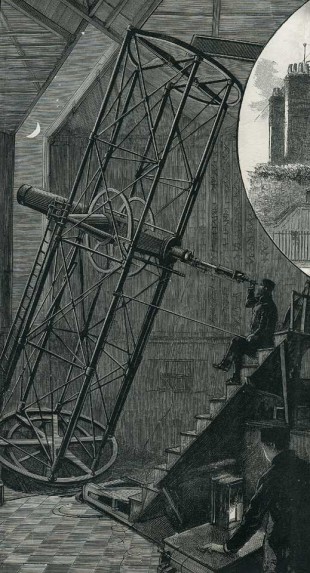
Christie's direct-vision 'half-prism' spectroscope in use on the 12.8-inch Merz Refractor. From the 8 August 1885 edition of The Graphic
‘This equatorial is provided with all the necessary adjuncts for making astronomical extra -meridional observations in every branch of the science. It is furnished with microscopes for reading the graduated circles, eye-pieces of different powers and construction, and other appliances too numerous to mention. If the position of a planet or star be wanted; if the magnitude or diameter of Jupiter. Saturn, or any object having a disc, be required; or, if the rapid changes noticed during an eclipse of the sun are to be measured, or, indeed, the observation of any other phenomenon, this instrument, in the hands of a skilful observer, will give results which no one can doubt.’
The telescope’s use began to change in 1863 when a ‘Prismatic Spectrum-Apparatus’ was made and fitted to allow the spectra of bright stars to be observed. This marked a tentative beginning to what became a full blown regular programme of spectroscopic observations following the creation of a Photographic and Spectroscopic Department in 1874. That year, the telescope was fitted with a spectroscope by Browning in 1874. This was replaced in 1877 by a direct-vision ‘half-prism’ spectroscope designed by Airy’s Chief Assistant, William Christie, and constructed by Adam Hilger.
In the years before the telescope was dedicated primarily to spectroscopic work, it was also fitted with a ‘thermo-multiplier’ in 1869 in order to detect radiant heat from bright stars but to carry this out, a certain degree of ingenuity was required. In his 1870 report, and long before the balcony was built on the exterior of the telescope dome, Airy informed the Visitors that:
‘A temporary rough bridge or gallery has been carried from the north-west window of the Equatoreal Room to the leads above the Library. The object of this is to give facilities to Mr. Stone's observations on the radiating heat of the stars. The thermopile is carried by the telescope of the Equatoreal; but it was found impracticable to use the galvanometer in the proximity of so much moving iron. Wires were, therefore, led from the thermo-pile to the Library, where the galvanometer could be efficiently used, and the bridge was constructed to give rapid transit from the telescope to the galvanometer.’
The first experiments in astrophotography were tried under Airy in 1875. Further experiments were carried out by Christie in February 1887. Because photographic plates were sensitive to a different range of frequencies than the human eye, a photographic corrector, consisting of a concave crown and convex flint lens (in contact) was placed about 30inches ‘within the focus’ in order to correct the chromatic aberration of the object glass for shorter wavelengths of light without altering the focal length of the telescope. Click here to read details from the Astronomer Royal’s Report. The experiments necessarily interrupted the regular programme of spectroscopic observations. Following an initial trial with the 12.8-inch, the experiments were continued with the Sheepshanks Equatorial.
On the Lassell Equatorial, 1892–1895
In 1859 in his report to the Board of Visitors, Airy stated that the mounting which carried the Merz refractor was capable of holding a larger telescope and that ‘it might with some inconvenience carry a telescope of above 20 feet focal length; and, if the regions near the pole were given up, it might carry one still larger.’ Some 25 years later, this is exactly what Christie proposed to do.
In 1885, in his report to the Board of Visitors, Christie tabled a proposal to replace the 12.8-inch Merz with a refractor with an aperture of 28-inches and a focal length of 28 feet on the same mounting. This was approved by the Board and subsequently by the Admiralty. It’s not clear at this point exactly what he planned to do with the dismounted 12.8-inch refractor. As things turned out, difficulty in securing glass blanks of sufficient quality for the new refractor meant that the 12.8-inch was able to remain in position until 1891. By then, there had been other developments. The 2-foot Lassell reflector that had been acquired in 1883 had failed to live up to expectations. Christie therefore hatched a plan to mount the Merz telescope in its place on the Lassell Equatorial. On 23 November 1891, the Merz telescope was dismounted from the Great Equatorial. According to the introductions in the volumes of Greenwich Observations, the Lassell reflector was also dismounted from the Lassell Equatorial in November 1891, and the Merz Refractor substituted with the Thompson 9-inch Photographic Telescope mounted beneath it. This however is contradicted by the Astronomer Royal’s Journal and his 1892 Report to the Board of Visitors in which states that the Lassell Reflector was not dismounted until 20 April 1892 and that the mounting of the Merz telescope whilst in hand, had still not been completed by 11 May. The report for 1893 states that the work was finished later that month (May 1892).
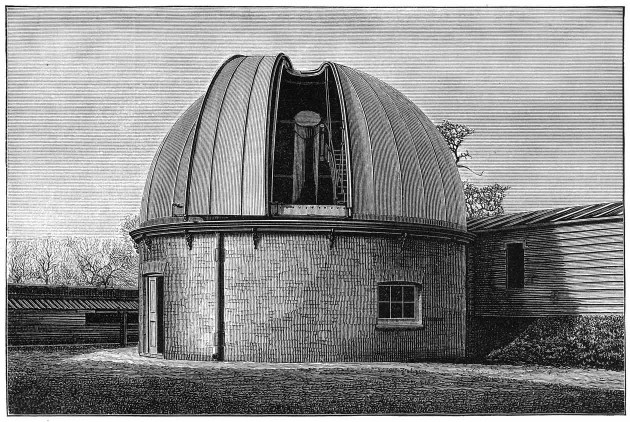
The Lassell 2-foot Reflector in the Lassell Dome at Greenwich. It was dismounted in 1892 and replaced with the 12.8-inch Merz Refractor. There are no know images of the Refractor in the dome. From: A Handbook of Descriptive and Practical Astronomy, Volume 2, Fourth Edition (London 1890) by George F Chambers
Meanwhile, plans that had first been mooted back in 1889 to build a museum type store attached to the Lassell Dome had evolved by the start of 1891 into a full scale redevelopment with the construction of a new cruciform building with four wings each of three stories, along with a central tower surmounted by the Lassell Equatorial and Dome (which were to be relocated). Work on the new building was begun in March 1891. In the same financial year, the Admiralty also agreed to replace the original Drum Dome of the Great Equatorial Building (which Christie had said would be perfectly suitable for use with the 28-inch refractor) with an onion shaped one better able to accommodate the extra length of the new telescope.
It would be interesting to know the detail of the discussions that Christie must have had with the Admiralty. Was there any discussion for example about keeping the Merz telescope in its original location and putting the 28-inch refractor on top of the new building under a new larger dome on a new purpose built mounting?
In the end, although the Lassell Dome was moved onto the new building, the Lassell Equatorial was not. This was because in 1894, Sir Henry Thompson offered to provide £5000 for the purchase of a large photographic refractor. It was this that was set up in the re-located Lassell Dome rather than the Lassell Equatorial which was effectively scrapped as a result. The Merz telescope was dismounted in July 1885 and the dome dismantled the following month prior to it being re-erected on the new building.
During its time on the Lassell Equatorial, the Merz telescope was used was used for the observation of comets and occultations &c. It was also used assiduously for the observation of double stars by Thomas Lewis, the observations being carried out in his own time. Rather ironically, although one of the main reasons for acquiring the 28-inch telescope was to develop further the programme of determinations of proper motions of the stars with the aid of a spectroscope, the restarted spectroscopic programme was abandoned only a year after the 28-inch telescope came into use, and the telescope devoted to Lewis’s double star work instead.
Re-tubed for use as a guiding telescope
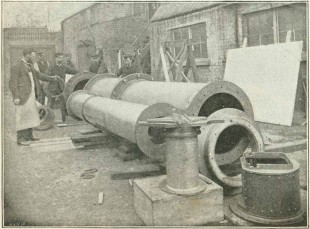
Putting together the tubes of the 26-inch Refractor at the Grubb works. The smaller of the two tubes on the left carried the Merz object glass. Photo by Sir Howard Grubb. From The Strand Magazine, Volume 12 (1896)
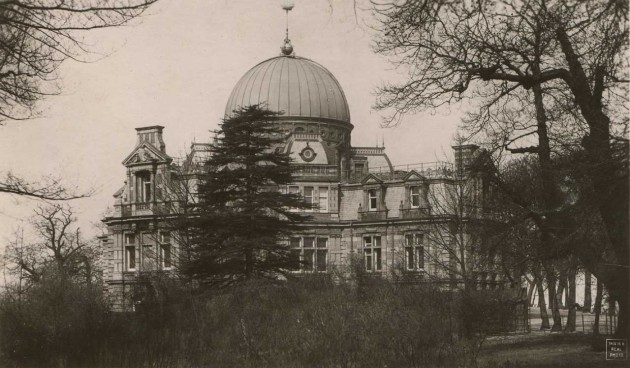
An early twentieth century view of the dome of the new building where the Merz telescope was housed from the end of 1896 until its move to Herstmonceux. From a postcard published by Manning & Son, Greenwich
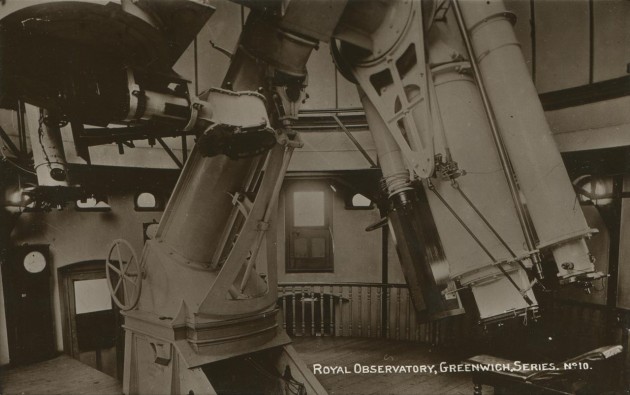
The Thompson Equatorial, which was housed in the dome above. The instrument carried The Thompson 30-inch Reflector (which is to the left of the pier) and the Thompson 26-inch Refractor (which is to the right). As well as carrying the re-tubed 12.8-inch Merz as it guiding telescope (extreme right), the refractor also carried the Thompson Photoheliograph. Postcard published by Henry Richardson, in around 1908
Transfer to Herstmonceux
In the early 1930s, the new Astronomer Royal, Harold Spencer Jones, sought to move the Observatory to a new site away from the pollution of Greenwich. With the outbreak of war, the plans were put on hold. By early 1944, the Admiralty had approved a move in principle and by 1946 a new site selected at Herstmonceux. Although the move to Herstmonceux commenced in 1948, post war austerity coupled with other delays meant that the large equatorials from Greenwich (which included the 26-inch Refractor) were not brought into use until the late 1950s. In the case of the 26-inch Refractor, this was 1958. The Equatorial Group consisted of a cluster of six domes labelled A to F. The 26-inch Refractor was assigned to dome E in the south-west corner of the group.
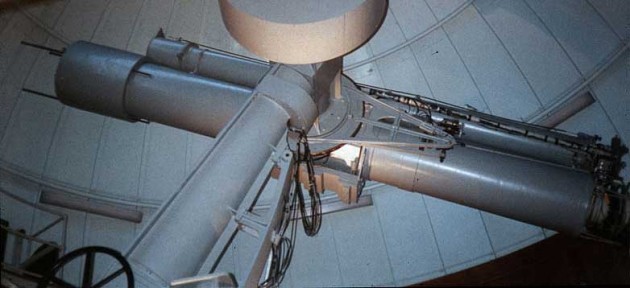
The Thompson 26-inch Photographic Refractor (below) with the 12.8-inch Merz Refractor as its guiding telescope (above) in its dome at Herstmonceux. Although the date of the photograph is unknown, it was probably taken in the 1970s or 1980s. Photo courtesy of Patrick Moore
The telescope remained at Herstmonceux when the Observatory vacated the site and moved to Cambridge at the end of the 1980s. The Herstmonceux site was sold to James Developments who later went into administration. In early 1993, the Castle was purchased for the Queen’s University of Ontario, Canada for use as an international study centre. The Equatorial Group came back to life in 1995 as The Observatory Science Centre, under the aegis of Science Projects. The Thompson Refractor complete with the Merz guiding telescope is now in their care.
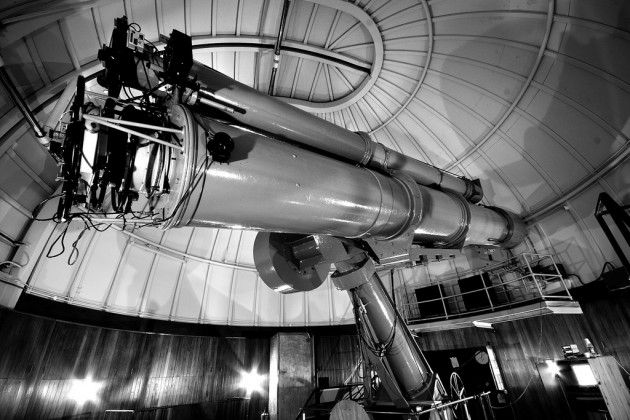
The Thompson 26-inch Photographic Refractor with the 12.8-inch Merz Refractor photographed at Herstmonceux in 2009. Reproduced under the terms of a Creative Commons Attribution-NonCommercial-NoDerivs (CC BY-NC-ND) licence courtesy of Melanie Davies (see below)
Contemporary accounts
As well as the brief account published above, Airy published a definitive technical account in the 1868 volume of Greenwich Observations which was published in 1870. It contains 55 figures spread over 8 plates. These were drawn in 1868/9 by ‘an accomplished draughtsman’ under the superintendence of Airy’s assistant, James Carpenter.
Description of the Great Equatorial at the Royal Observatory, Greenwich. Airy G.B. Appendix 3 to the 1868 volume of Greenwich Observations.
The earliest published description of the telescope was probably that published by the Illustrated London News in 1861.
The Equatorial in Greenwich Observatory. The Illustrated London News, 24 August 1861, p.205
Further reading
The Object-Glass of the Greenwich Great Equatorial Telescope. Lowne, C. M. Journal for the History of Astronomy, Vol.19, NO. 3/AUG, P.169, 1988
The 28-inch Refractor at Greenwich – a History of Two Telescopes. Wright, D. C., Quarterly Journal of the Royal Astronomical Society, Vol.31, NO. 4/DEC, P.551, 1990
Thomas Lewis: a lifetime of double stars. Wright, D. Journal of the British Astronomical Association, vol.102, no.2, p.95–101 (1992)
Image Credits and licensing arrangements
| 2nd from bottom | The Thompson 26-inch Photographic Refractor with the 12.8-inch Merz Refractor at Herstmonceux in the 1970s or 1980s. Photo reproduced from The Patrick Moore Collection courtesy of Patrick Moore |
|
| Bottom | The Thompson 26-inch Photographic Refractor with the 12.8-inch Merz Refractor photographed at Herstmonceux in 2009. Reproduced under the terms of a Creative Commons Attribution-NonCommercial-NoDerivs (CC BY-NC-ND) licence courtesy of Melanie Davies. For link to original image click here |
© 2014 – 2025 Graham Dolan
Except where indicated, all text and images are the copyright of Graham Dolan
